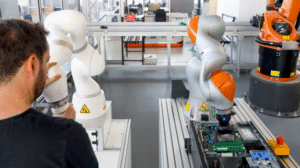In an era where smartphones are ubiquitous, the environmental toll of electronic waste (e-waste) is staggering. Every year, millions of old phones end up in landfills, leaking toxic materials and wasting precious resources. But what if AI-powered robots could efficiently take apart your discarded phone, recovering valuable components for reuse? This innovative technology is not science fiction—it’s already transforming the recycling industry. Companies like Apple, ABB Robotics, and startups such as Molg are leading the charge, making phone disassembly faster, smarter, and more eco-friendly. In this post, we’ll explore how these robots work, their benefits, and what the future holds for sustainable electronics.

What Are AI-Powered Disassembly Robots?
AI-powered disassembly robots are advanced machines designed to break down electronic devices like smartphones into their core components. Unlike traditional manual recycling, which is labor-intensive and inefficient, these robots use artificial intelligence to identify, sort, and extract parts with precision. For instance, Apple’s Daisy robot, introduced in 2018 and continually upgraded, specializes in iPhone disassembly. It can handle up to 23 different iPhone models, processing around 1.2 million devices annually.
Meanwhile, collaborations like that between ABB Robotics and Molg are pushing boundaries further. In 2025, they announced robotic microfactories aimed at disassembling data center servers and consumer electronics, including phones. These systems leverage AI to adapt to various device designs, making them versatile for the ever-evolving tech landscape. Other research initiatives, such as the REMADE Institute’s projects, focus on developing AI tools that enable robots to harvest parts from diverse phone models, addressing the challenge of non-standardized electronics.
These robots represent a shift from destructive shredding methods—common in e-waste processing—to intelligent deconstruction, preserving high-value materials like rare earth elements, gold, and cobalt.
How Do These Robots Work?
The magic lies in the integration of robotics, computer vision, and machine learning. Take Apple’s Daisy: This 10-meter-long assembly line consists of multiple robotic arms that work in sequence. It starts by removing the screen, then unscrews batteries, cameras, and other modules using specialized tools. Daisy operates at impressive speeds, disassembling one iPhone every 18 seconds—or up to 200 per hour. Sensors and AI algorithms help it recognize different models and adjust its actions accordingly, ensuring minimal damage to recoverable parts.
In the case of ABB and Molg’s technology, AI plays a central role in planning disassembly paths. The robots use machine learning models trained on vast datasets of electronic designs to predict the best way to dismantle a device. For example, they can identify screws, adhesives, or clips hidden inside a phone’s casing. Computer vision systems scan the device in real-time, mapping out components and avoiding fragile areas. This adaptability is crucial because phones from brands like Samsung, Google, or Huawei vary widely in construction.
Research from institutions like the University at Buffalo highlights AI’s role in overcoming variability. By employing algorithms that learn from previous disassemblies, robots can handle unfamiliar models, reducing errors and increasing efficiency. The process ends with sorted materials ready for smelting or reuse, turning what was once waste into raw inputs for new products.
Benefits for the Environment and Economy
The advantages of AI-powered phone disassembly are profound. Environmentally, it tackles the e-waste crisis head-on. According to the United Nations, 62 million tonnes of e-waste were generated in 2022, with only 22% properly recycled. This waste equates to $63 billion in lost recoverable materials annually, projected to exceed $80 billion by 2030. Robots like Daisy recover cobalt for batteries, tungsten for vibration motors, and rare earth magnets, reducing the need for mining—which often devastates ecosystems.
Economically, these technologies create value from trash. Apple, for instance, uses recycled materials in new devices, closing the loop on its supply chain and aiming for carbon neutrality by 2030. For recyclers, AI robots boost throughput and yield, making operations profitable. They also enhance worker safety by handling hazardous tasks, such as dealing with lithium-ion batteries that can ignite if mishandled.
Moreover, widespread adoption could democratize recycling. Smaller facilities could deploy modular robotic systems, making sustainable practices accessible beyond tech giants. This shift not only conserves resources but also fosters innovation in circular economies, where products are designed for easy disassembly from the start.
Challenges and Future Outlook
Despite the promise, challenges remain. High initial costs for robotic setups limit accessibility for smaller recyclers. Variability in device designs requires constant AI training, and not all materials are easily recoverable—plastics often end up incinerated. Regulatory hurdles, like varying e-waste laws across countries, also complicate global implementation.
Looking ahead, the future is bright. Advances in AI, such as generative models for simulating disassembly, could make robots even smarter. Collaborations like ABB-Molg aim to scale microfactories worldwide, potentially handling billions of devices. By 2030, we might see AI robots in everyday recycling centers, turning your old phone into components for the next generation of gadgets. Governments and companies must invest in these technologies to combat e-waste effectively.
Conclusion
AI-powered robots are redefining how we handle end-of-life phones, turning a global problem into an opportunity for sustainability. From Apple’s efficient Daisy to emerging microfactories, these innovations promise a greener tech world. As consumers, we can contribute by recycling our devices responsibly. The next time you upgrade your phone, remember: an AI robot might just give it a second life. Embracing this technology isn’t just smart—it’s essential for our planet’s future.
